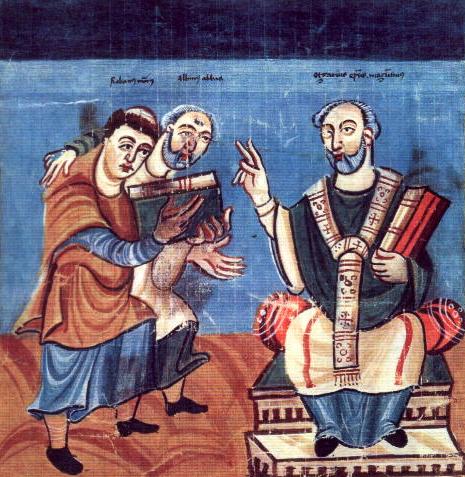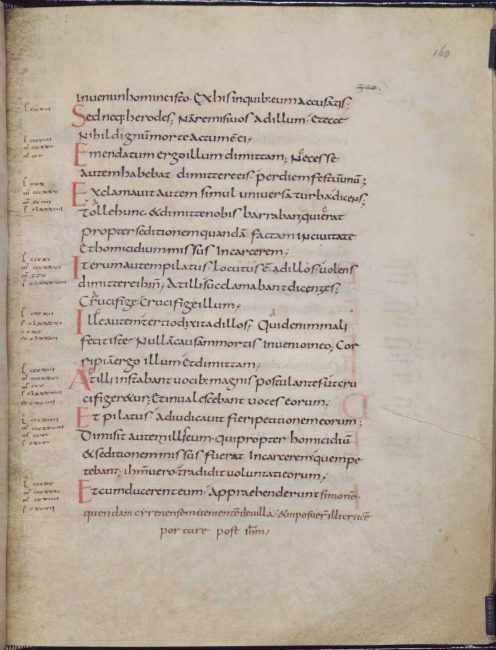
Carolingian Manuscript, Rabanus Maurus (left), with Alcuin (middle), dedicating his work to Archbishop Odgar of Mainz (right)
On May 19, 804 AD, English scholar, ecclesiastic, poet and teacher Alcuin of York passed away. At the invitation of Charlemagne, he became a leading scholar and teacher at the Carolingian court. He wrote many theological and dogmatic treatises, as well as a few grammatical works and a number of poems. According to Einhard’s Life of Charlemagne, Alcuin was “the most learned man anywhere to be found“.
“And those people should not be listened to who keep saying the voice of the people is the voice of God, since the riotousness of the crowd is always very close to madness.”
— Alcuin of York, Works, Epistle 127 (to Charlemagne, AD 800)
Alcuin of York – Early Life
Alcuin grew up in Yorkshire as the son of a nobleman. He attended the internationally well known school in York, mostly famous for its liberal arts, literature, and science, as well as in religious studies. He graduated, became a teacher and deacon in the church in the 750s. Even though he used to live his life as a monk, he was never ordained a priest or became a monk officially.
Meeting Charlemagne and the School of Master Albinus
‘Remember to care for the soul more than the body, since the former remains, the latter perishes.”
– Alcuin of York
It is assumed that he met Charlemagne for the first time in 781 in Parma. He convinced Alcuin to follow his invitation to Aachen, where he was appointed teacher of a renowned school. Later on, Alcuin is believed to have said that “the Lord was calling me to the service of King Charles“. He was welcomed at the Palace School of Charlemagne in Aachen around 782. The school was founded by Charles’ ancestors as a place to educate the royal children. Charlemagne also wanted to include liberal arts as well as religion. Alcuin not only taught the royal children, but also the king himself and his sons Pepin and Louis. Alcuin managed to create a personalized atmosphere of scholarship and learning, and the school became later well known as the “school of Master Albinus“. Alcuin had a great influence on the young elite of the area and was already considered as one of the greatest scholars of his time.
Changing the Policy against Pagans
Next to his teaching duties, he took his role as a religious and political advisor very seriously and his ideas were highly respected by the emperor. Alcuin tackled him over his policy of forcing pagans to be baptised on pain of death, arguing, “Faith is a free act of the will, not a forced act. We must appeal to the conscience, not compel it by violence. You can force people to be baptised, but you cannot force them to believe“. These arguments seem to have prevailed, because Charlemagne decided to abolish the death penalty for paganism in 797. Charlemagne was known to befriend many of his men at court and they used to refer to him as ‘David’. Also Alcuin found himself on intimate terms with Charlemagne and the other men at court.

Carolingian minuscule, one of the products of the Carolingian Renaissance.
The Carolingian Minuscle
Alcuin made the abbey school into a model of excellence and many students flocked to it. He had many manuscripts copied using outstandingly beautiful calligraphy, the Carolingian minuscule based on round and legible uncial letters. Alcuin also developed manuals used in his educational work – a grammar and works on rhetoric and dialectics. These are written in the form of dialogues, and in two of them the interlocutors are Charlemagne and Alcuin. He wrote several theological treatises: a De fide Trinitatis, and commentaries on the Bible. Alcuin is also credited with inventing the first known question mark, though it didn’t resemble the modern symbol.
The Heresy of Adoptionism
Alcuin returned to England in 790, but came back to help Charlemagne in the fight against the Adoptionist heresy which was at that time making great progress in Toledo. Alcuin is believed to have had contacts with Beatus of Liébana, from the Kingdom of Asturias, who fought against Adoptionism. He upheld the orthodox doctrine and obtained the condemnation of the heresiarch Felix of Urgel. Having failed during his stay in Northumbria to influence King Æthelred in the conduct of his reign, Alcuin never returned home. He continued working at Charlemagne’s court and retired from his duties in 796. Alcuin passed away on 19 May, 804. He was buried at St. Martin’s Church under an epitaph that partly read:
Dust, worms, and ashes now …
Alcuin my name, wisdom I always loved,
Pray, reader, for my soul.
The Carolingian Renaissance
During his lifetime, Alcuin wrote numerous letters that are now an important source of information concerning the literary and social conditions of the time and a reliable authority for the history of humanism during the Carolingian age. Alcuin was an important mediator of the Latin education saved in England and Ireland through the time of the migration of peoples into the Frankish Empire, which he taught to numerous pupils, among them Hrabanus Maurus and Charlemagne himself. Today, he is considered as the most prominent figure of the Carolingian Renaissance. The oldest collection of mathematical problems in Latin, the Propositiones ad acuendos iuvenes, is attributed to Alcuin. One of its solutions is the Alquin sequence named after him. Poems – including a letter poem to Charlemagne and the Aachen Court Society -, sermons, historiographical, biographical and theological works as well as treatises on rhetoric, dialectics and astronomy are also preserved. The greatest contemporary widespread impact was probably the revision of the Vulgate begun by Alcuin. At his suggestion, the so-called Alcuin bibles, biblical panels with the revised Vulgate text and elaborate illuminations were created in his Saint-Martin de Tours monastery.
Gregory B. Sadler, Alcuin of York | On Virtues and Vices | Fasting, Almsgiving, and Chastity, [13]
References and Further Reading:
- [1] Alcuin’s Problems to sharpen the Young
- [2] Alcuin of York at the Internet Archive
- [3] Charlemagne and the Birth of Europe, SciHi Blog
- [4] Charles Martell and the Battle of Tours and Poitiers, SciHi Blog
- [5] O’Connor, John J.; Robertson, Edmund F., “Alcuin“, MacTutor History of Mathematics archive, University of St Andrews.
- [6] Works by or about Alcuin at Internet Archive
- [7] Alcuin of York at Wikidata
- [8] Works by or about Alcuin of York at Wikisource
- [9] The Alcuin Society
- [10] Alcuin’s book, Problems for the Quickening of the Minds of the Young
- [11] Lorenz, Frederick. The life of Alcuin (Thomas Hurst, 1837) at the Internet Archive.
- [12] Page, Rolph Barlow. The Letters of Alcuin (New York: Forest Press, 1909) at the Internet Archive.
- [13] Gregory B. Sadler, Alcuin of York | On Virtues and Vices | Fasting, Almsgiving, and Chastity, Gregory B. Sadler @ youtube
- [14] Timeline of Medieval Linguists, via DBpedia and Wikidata





